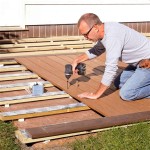Patio Slope: A Comprehensive Guide to Design and Functionality
The design and construction of a patio involve numerous considerations, encompassing materials, dimensions, aesthetics, and, crucially, drainage. One of the most fundamental decisions to make is whether the patio should have a slope, and if so, what degree of slope is appropriate. This decision significantly impacts the patio's longevity, usability, and potential for water damage to surrounding structures. This article provides a detailed exploration of the implications of patio slope, examining both the rationale for incorporating a slope and the potential drawbacks of neglecting this crucial design element.
The primary purpose of a patio is to provide a functional and aesthetically pleasing outdoor living space. However, without proper drainage, a patio becomes susceptible to water accumulation, which can lead to a host of problems. These issues range from merely inconvenient puddles to more serious structural damage, including erosion, cracking, and foundation instability. The inclusion of a carefully planned slope is the most effective way to mitigate these risks and ensure the patio remains a durable and enjoyable feature of the property.
The decision to slope a patio is not merely a matter of preference; it is a matter of engineering and functionality. A well-sloped patio will channel water away from the house and prevent the formation of standing water, thus minimizing the risk of water damage and creating a safer, more user-friendly outdoor space. Conversely, a patio without a slope is more likely to experience water accumulation, leading to potential hazards and premature deterioration.
The Importance of Proper Drainage
The cornerstone of any successful patio design is effective drainage. Without it, rainwater, snowmelt, and even accidental spills can accumulate on the patio surface. This standing water poses a number of problems. Firstly, it creates a slipping hazard, especially during colder months when the water can freeze, turning the patio into an ice rink. Secondly, standing water can promote the growth of mold and mildew, which not only degrades the aesthetic appeal of the patio but also poses a potential health risk. Thirdly, prolonged exposure to water can damage the patio material itself, leading to cracking, erosion, and ultimately, the need for costly repairs.
Furthermore, improper drainage can have a detrimental impact on the surrounding landscape and structures. Runoff from a poorly drained patio can saturate the soil around the foundation of the house, increasing the risk of water seepage into the basement or crawl space. This can lead to significant structural damage, including foundation cracks, mold growth within the house, and even compromised structural integrity. In addition, excessive runoff can erode garden beds and damage landscaping features adjacent to the patio.
The inclusion of a proper slope is the most effective way to address these drainage concerns. By creating a subtle gradient, rainwater is directed away from the house and toward a designated drainage area, such as a lawn, garden bed, or drainage system. This prevents the accumulation of standing water, minimizes the risk of water damage, and ensures the patio remains a safe and functional outdoor space.
Determining the Appropriate Slope
The ideal slope for a patio is typically expressed as a ratio, indicating the amount of vertical drop for every foot of horizontal distance. A commonly recommended slope is 1/4 inch per foot. This means that for every foot of patio surface, the patio should slope downward by 1/4 inch. This gentle gradient is usually sufficient to ensure adequate drainage without being visually noticeable or creating an uneven surface that could be uncomfortable to walk on or place furniture on.
However, the appropriate slope may vary depending on several factors, including the size of the patio, the type of patio material used, and the local climate. Larger patios may require a more pronounced slope to effectively channel water away from the house. Porous patio materials, such as gravel or permeable pavers, may require a slightly shallower slope, as they allow some water to percolate directly into the ground. In regions with heavy rainfall, a steeper slope may be necessary to prevent water from pooling on the patio surface during intense storms.
When determining the appropriate slope for a patio, it is crucial to consult with a qualified landscape architect or contractor. These professionals have the expertise and experience to assess the specific site conditions and recommend a slope that will ensure optimal drainage and long-term patio performance. They can also advise on the best drainage solutions for directing runoff away from the house and preventing water damage to the surrounding landscape.
Exceptions and Alternative Drainage Solutions
While a sloped patio is generally the best approach for ensuring proper drainage, there may be certain situations where a level patio is preferred or necessary. For example, if the patio is designed to be flush with an existing deck or porch, creating a slope may be impractical or aesthetically undesirable. In such cases, alternative drainage solutions must be implemented to prevent water accumulation.
One common alternative is the installation of a drainage system around the perimeter of the patio. This can involve a trench drain, which is a narrow channel covered with a grate that collects surface water and directs it to a drainage pipe. Another option is the use of permeable pavers, which allow water to percolate through the patio surface and into the ground below. Permeable paver systems often include a gravel base that provides additional drainage and filtration.
Another approach is to incorporate strategic grading around the patio to direct water away from the house. This involves carefully shaping the surrounding landscape to create a gentle slope that channels runoff toward a designated drainage area. This can be particularly effective in conjunction with a French drain, which is a gravel-filled trench with a perforated pipe that collects subsurface water and carries it away from the foundation.
Regardless of the drainage solution chosen, it is essential to ensure that the system is properly designed and installed to effectively manage water runoff and prevent water damage. Regular maintenance, such as cleaning debris from drains and inspecting drainage pipes, is also crucial to ensure the long-term performance of the drainage system.
In conclusion, the decision to slope a patio is a critical design consideration that has a significant impact on its functionality, longevity, and potential for water damage. While a sloped patio is generally the best approach for ensuring proper drainage, alternative solutions can be implemented in situations where a level patio is preferred or necessary. Consulting with a qualified landscape architect or contractor is essential to determine the optimal drainage solution for a given site and ensure that the patio remains a safe, durable, and enjoyable outdoor space for years to come.

Paver Patio Slope For Drainage How To Hardscape
Questions On Sloping A Raised Patio Lawn Care Forum

How Do I Slope A Patio Toward One Of Its Corners Home Improvement Stack Exchange

How To Slope A Concrete Patio For Drainage Doityourself Com
Building Paver Patio On Slope Pics Lawn Care Forum

What Is A Normal Slope For New Paver Patios Viking Pavers

Can You Build A Patio On Sloped Yard Lawn Landscape

How Much Slope Should Your Patio Roof Cover Have

Grading A Patio Located Away From House

Is My Patio Base Slope Too Steep
See Also








